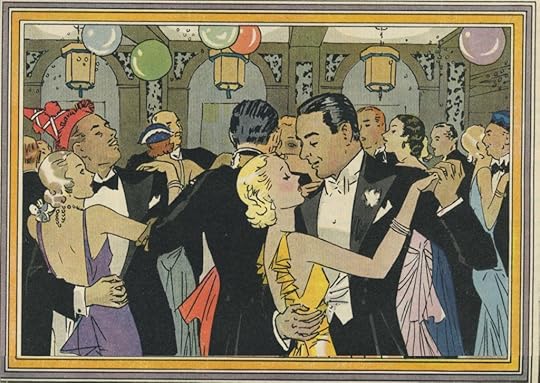The Paris Review's Blog, page 192
December 31, 2019
On Classic Party Fiction
We’re away until January 6, but we’re reposting some of our favorite pieces from 2019. Enjoy your holiday!

Irving Nurick, illustration from the 1920s
In her 2008 review of Cecily von Zeigesar’s Gossip Girl novels, Janet Malcolm quotes the eponymous narrator’s “opening volley”: “We all live in huge apartments with our own bedrooms and bathrooms and phone lines. We have unlimited access to money and booze and whatever else we want, and our parents are rarely home, so we have tons of privacy. We’re smart, we’ve inherited classic good looks, we wear fantastic clothes, and we know how to party.” I’ve never read the books myself, but on the CW show, which I was briefly obsessed with, we hear Kristen Bell’s voice-over during the title sequence: “Gossip Girl here! Your one and only source into the scandalous lives of Manhattan’s elite.” The actors playing these trust-fund teens aren’t just good-looking; they seem like genetic impossibilities. Blake Lively is perfectly cast as the, in Malcolm’s words, “incandescently beautiful” Serena van der Woodsen. She’s 5’10” and usually wearing heels. Heather Cocks and Jessica Morgan of the blog Go Fug Yourself used to call her “Boobs Legsly.” Serena and her friends and enemies (there is often little distinction between the two) have not only lucked into the 1 percent, they are also having an unfair amount of fun.
Classic party fiction is often, if not always, a kind of wealth porn. When Emma Bovary arrives at La Vaubyessard, the chateau of the marquis, for dinner and a ball, the opulence blows her bourgeois mind: “The red claws of the lobsters overhung the edges of the platters; large fruits were piled on moss in openwork baskets; the quails wore their feathers; coils of steam rose into the air; and, grave as a judge in his silk stockings, knee breeches, white tie, and jabot, the butler conveyed the platters.” Party scenes are full of these lists of foods and drinks and flowers, overloaded sentences that embody abundance, the fulsome displays of affluence. See Nick Carraway’s first party at Jay Gatsby’s: “Every Friday five crates of oranges and lemons arrived from a fruiterer in New York … On buffet tables, garnished with glistening hors d’oeuvre, spiced baked hams crowded against salads of harlequin designs and pastry pigs and turkeys bewitched to a dark gold.” Was Flaubert the first to use this listing trope, appalled by the excess? Jane Austen’s balls are disappointingly devoid of visual detail, as if the evidence of money was just assumed. (Austen’s novels adapt so well into film because the dialogue is all there, and costume and set designers can supply the surrounding lushness.) A truly expensive party should feel otherworldly; the marquis’s ball, by putting her in “contact with wealth,” leaves Emma utterly changed. It makes “a hole in her life, like those great chasms that a storm, in a single night, will sometimes open in the mountains.”
December 30, 2019
Objects of Despair: Fake Meat
We’re away until January 6, but we’re reposting some of our favorite pieces from 2019. Enjoy your holiday!

The Impossible Burger.
Science lifted us out of nature. It tamed the wilderness; it gave us tools to transcend our lousy, fallen bodies; and it shot us to the moon. Now it has produced a hamburger made entirely of vegetables that bleeds like real beef. The packaging of the aptly named Impossible Burger instructs you, as if daring you, to cook the patties medium rare. Three minutes on each side, and the center will remain the fleshly pink color of raw sirloin. This effect is the result of heme, the protein that carries oxygen through our blood and gives it its crimson color, and which food scientists have discovered how to ferment in a lab using genetically engineered yeast. (Pedantic foodies will point out that the red in beef is not blood but myoglobin, but this is beside the point. We call burgers “bloody” to acknowledge a truth that modernity has long tried to obscure: that meat was once, like us, a living thing.) Heme, which is abundant in animal muscle, is also what lends beef its distinctive flavor. The first time I prepared the Impossible Burger at home, the skillet erupted into a fatty sizzle (the patty contains emulsified coconut oil, which melts like tallow), and within seconds the air filled with the iron aroma of singed flesh. But the most uncanny moment arrived when I finished eating and there remained on the plate a stain of pinkish-brown drippings. In that moment, when I should have been marveling at the wonders of food science, I confess I was thinking of the weeping Madonna of Civitavecchia, a wooden statue that was said to shed tears of real blood—the signs of flesh where there is none.
One Word: Bitch
We’re away until January 6, but we’re reposting some of our favorite pieces from 2019. Enjoy your holiday!
I can tell who’s calling me from across the room by the pitch of their bitch. Fati goes up on the i so that it’s almost a shriek. Hieu gets a little gravelly, dark and full, bitch as precursor to some good gossip. Blaire says it flat, matter-of-fact, like a name. Franny says it like a bell, a sweet call to fellowship. I love my bitches. I love being bitched by them. It’s an insult we’ve spun into coin.
The femmes and queers I have known have saved my life. The deep wells of care from femmes; the ingenuity of queer love. Bitch is the passport to that nation. Or maybe it’s the national anthem, how we sing our love to each other. Maybe it’s our language.
When I am bitched by the homies, there is no threat on my life. There is no car following me as I hightail it home, bitch flung out the window, faggot close behind. There is no accusation like back in high school when bitch was a charge made by a fellow boy who could smell the girl in you, or a boy who loved/hated your girl-body or a boy whose only tongue was violence. I used to be scared of coming off bitch-made. You know: scary, sissy, punk, femme. All those words that I now wear as crowns lurked in the corners of boys’ mouths. I was terrified, trying to exact my walk and perfect a boy-tongue, scared someone would see through my act and spot the bitch in me.
December 27, 2019
Listen to Hebe Uhart, Now That She’s Gone
We’re away until January 6, but we’re reposting some of our favorite pieces from 2019. Enjoy your holiday!

Hebe Uhart. Photo: Agustina Fernández.
In section 16, grave 34 of the Chacarita Cemetery in Buenos Aires, pumpkins and tomatoes now grow. Pumpkins and tomatoes, just like that. A scene that could have been written by Hebe Uhart, who, since October 12, 2018, has lain in a grave there. An image worthy of her stories: reality interrupted by strangeness. “A story is a little plant that’s born,” Uhart used to say that Felisberto Hernández used to say. Hernández was one of her go-to authors, along with Natalia Ginzburg, Fray Mocho, and Simone Weil. Uhart starts her magnificent story “Guiding the Ivy” by announcing, “Here I am arranging the plants so they don’t overcrowd one another, pulling off dead leaves, and getting rid of ants.”
*
Some time ago, at the launch party for one of her books, Hebe Uhart—born in 1936 in Moreno, Argentina, author of some fifteen volumes of stories, novels, and chronicles, winner of the 2017 Manuel Rojas Ibero-American Narrative Award, rural schoolteacher, philosophy professor in her youth and leader of literary workshops until the end of her days, curious in the extreme, chronic traveler, and admirer of the animal kingdom—confessed the following:
I follow Chekhov’s advice, which I believe in absolutely: forget about the content of what the characters say and pay attention to how they say it, look at how the characters move, how they walk, how they are silent. I’m interested in people’s specificity.
How we move, how we walk, how we keep quiet: that is what Uhart observes in each of us. But also how we pause, how we sneeze, what onomatopoeias we use, how our being is revealed through everyday gestures that at times can contradict the ideas we claim to hold. It’s through these minute observations, and her repudiation of generalities, that the writer unfurls her tentacles to construct her characters. And along the way she sets the coordinates for a wisdom of her own, old and at the same time very simple: one of permanent awe. In the pages of her books are the primordial questionings, the first attempts to understand the world—“the who-am-I’s and the what-am-I-like’s,” as the protagonist of one of her stories says. What are we? Where are we going? Where did we come from? The classic questions of philosophy are in her pages anchored to the most domestic of situations. Hebe Uhart trains her eye on the things we witness so often that eventually we stop seeing them.
December 26, 2019
Our Town and the Next Town Over
We’re away until January 6, but we’re reposting some of our favorite pieces from 2019. Enjoy your holiday!

The author as a child, dressed as Oscar the Grouch.
Every year it floods on three sides of our town. I do not know how any town could have floods on three sides, but there it is. My mom says it is because the very rich people who live on the lake to the south of us keep the water levels too high so they can run their speedboats year-round, and then every spring, the rains come and we flood, and no one cares because we are all poor. It floods to the south along the river with the park with all the pavilions and the baseball diamonds and the tennis courts and the Frisbee golf course, and the small municipal (in-ground!) pool. And it floods on the southeast, behind the high school, and the motels near the highway. The Townsman Inn and Restaurant and Lounge has been renovated twenty times in half as many years, due to floods, most recently to feature taxidermy animals, on a shelf above all the booths, that stare at you in a menacing way over your coffee. And the one little tiny movie theater in town just seems to have water standing in the first three rows forever and always, and yet it remains open and we go see movies there, we just don’t sit in the first three rows. It floods to the northeast of town, too, all the way up practically to my Uncle Fuzz’s place, where he sleeps in the daytime while my aunt Margie sups on Sweet’N Low. There is the rust-red creek creeping up the concrete steps of my Uncle Fuzz’s house, while he is sleeping by day, because he is on graveyard shift his whole adult life at the tire factory, until he retires early with asbestos poisoning (from the tire factory).
Dice Roll: The Phantom Gambler
We’re away until January 6, but we’re reposting some of our favorite pieces from 2019. Enjoy your holiday!
On September 24, 1980, a man wearing cowboy boots and carrying two brown suitcases entered Binion’s Horseshoe Casino in Las Vegas. One suitcase held $777,000 in cash; the other was empty. After converting the money into chips, the man approached a craps table on the casino floor and put everything on the backline. This meant he was betting against the woman rolling the dice. If she lost, he’d double his money. If she won, he’d lose everything. Scarcely aware of the amount riding on her dice, the woman rolled three times: 6, 9, 7.
“Pay the backline,” said the dealer. And just like that, the man won over $1.5 million. He calmly filled the empty suitcase with his winnings, exited Binion’s into the desert afternoon, and drove off. It was the largest amount ever bet on a dice roll in America.
“Mystery Man Wins Fortune,” the Los Angeles Times reported. No one knew the identity of the fair-haired young Texan who’d just made history, and so he became known as the “Phantom Gambler.” “He was cool,” said Jack Binion, president of the Horseshoe. “He really had a lot of gamble in him.” But it would be years before the phantom would be seen in Vegas again.
One Word: Salty
We’re away until January 6, but we’re reposting some of our favorite pieces from 2019. Enjoy your holiday!
One kid raises their hand.
They ask, “Miss Gurba, why’d you become a high school teacher?”
This is a classic time-killing move.
My tone turns serious. I respond, “It was an accident.”
Hearing a public school employee be so blunt widens kids’ eyes.
They’ve baited me into a tacit game of truth or dare and I’ve knowingly broken the rules. I’m pretty sure they expect me to belt out the opening lyrics of “Greatest Love of All.” They want a saint.
What garbage. Catholics raised me, but I’m not a martyr. Still, even teenagers know you’re not supposed to admit that you stumbled into their classroom, but who cares? I did and I stayed and I continue to stumble in every morning.
Something my students ask me less often is whether or not I like teaching.
Something they ask me even less often than that is what I like about my profession.
December 25, 2019
On Cussing
We’re away until January 6, but we’re reposting some of our favorite pieces from 2019. Enjoy your holiday!
So. We cuss. Some of us cuss by saying mercy me or suffering succotash. I like to say shooty-pooty, which I learned from a nice Baltimore boy back in 1963. It’s a Cub Scout version of shitty-pity, which is a cutesy diminutive for just plain shit.
This kind of substitution for a cuss word is what linguists call an amelioration. It softens the blow while still addressing the topic. This is not the same as a euphemism, by the way, which tries to evade or screen the subject. Americans are big on substitute amelioration. We invent thousands of them daily, it seems. Darn for damn, gosh for God. They often sound as though we started to say the taboo word but caught ourselves.
Almost all of us have darker vocabularies if we’re pushed. We all have strong vocal reactions to pain and surprise, to anger or fear. We often use the same language in response to the strong positive stimulus of pleasure or awe or humor. Cuss words and phrases, whatever they may be in our individual vocabularies, are the most potent words we have for expressing emotion.
The Evil Stepmother
We’re away until January 6, but we’re reposting some of our favorite pieces from 2019. Enjoy your holiday!

Franz Juttner, Illustration from Snow White, c.1905
The stepmother swings like a light bulb back and forth, causing the mother who is not there to glow. That is her job.
I am a mother, a stepmother, and a step-stepmother because I am my husband’s third wife and he has daughters from his first marriage and a daughter from his second. And I am a mother-mother to our two sons. “This isn’t one of your fairy tales,” my husband once said to me during an argument. He didn’t mean Disney, he meant Grimm. He meant I was stowing myself in the body of a fairy-tale stepmother and setting sail.
When all my husband’s daughters are in our house at once, I grow very small. The weight of those girls who are not mine tilts the house and slides me toward the door. The weight of my sons slides me back in. Up and down goes this seesaw. My husband takes no turns. He grows weightless and blurry.
On weekends, my seventeen-year-old stepdaughter comes out of her bedroom in the early afternoon in a thick white robe. She moves slowly, like a gathering cloud. My sons worship her. She is soft and kind, and they scramble all over her body like mice. “Play with us,” they beg. She yawns. Shuffles into the bathroom. They wait by the door. Often she is in there for a long, long time. Her name is Eve, like the first woman on earth.
I love my stepdaughter, but I don’t love being a stepmother. It’s grim work. If we stood side by side, Eve and I, and looked into the mirror, it wouldn’t be our reflections staring back at us. It would be something wild and cruel. A discarded mother skin. A punishment for loving what doesn’t belong to you.
The Crane Wife
We’re away until January 6, but we’re reposting some of our favorite pieces from 2019. Enjoy your holiday!

Original illustration © Daniel Gray-Barnett
Ten days after I called off my engagement I was supposed to go on a scientific expedition to study the whooping crane on the gulf coast of Texas. Surely, I will cancel this trip, I thought, as I shopped for nylon hiking pants that zipped off at the knee. Surely, a person who calls off a wedding is meant to be sitting sadly at home, reflecting on the enormity of what has transpired and not doing whatever it is I am about to be doing that requires a pair of plastic clogs with drainage holes. Surely, I thought, as I tried on a very large and floppy hat featuring a pull cord that fastened beneath my chin, it would be wrong to even be wearing a hat that looks like this when something in my life has gone so terribly wrong.
Ten days earlier I had cried and I had yelled and I had packed up my dog and driven away from the upstate New York house with two willow trees I had bought with my fiancé.
Ten days later and I didn’t want to do anything I was supposed to do.
The Paris Review's Blog
- The Paris Review's profile
- 305 followers







